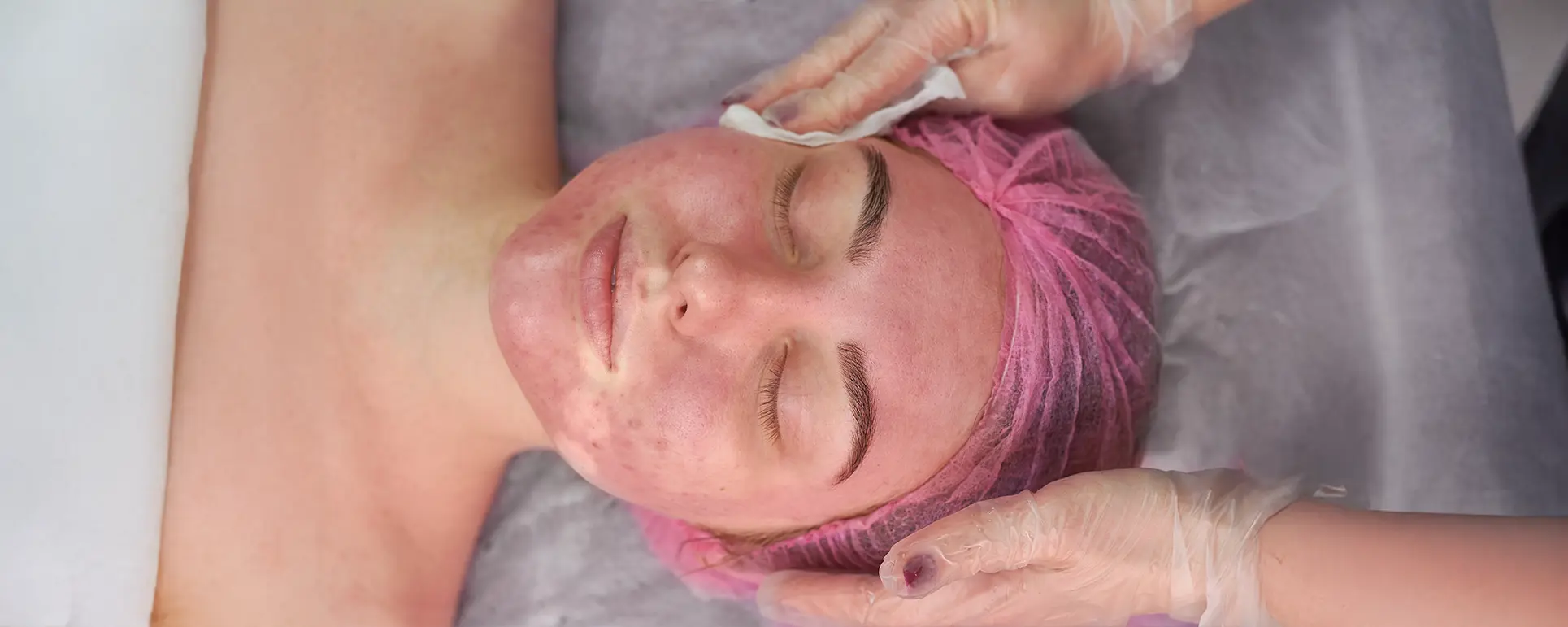Eczema and psoriasis are two of the most common skin conditions that dermatologists see in their clinics. And at first glance, they can look surprisingly alike especially if you’re experiencing them for the first time. Both can cause dry, red, scaly patches on the skin, and both can be incredibly itchy and uncomfortable. In some cases, the inflammation and irritation can be so severe that it affects your sleep, confidence, and overall quality of life.
It’s no surprise, then, that many people struggle to tell them apart. Even on close inspection, the symptoms can overlap enough to make it confusing. That’s why accurate diagnosis is key. While eczema and psoriasis may share some visual and sensory similarities, they are in fact very different conditions beneath the surface. They each have unique causes, underlying mechanisms, symptom patterns, and treatment approaches.
So, how exactly do dermatologists tell the difference between eczema and psoriasis? What clues do they look for during a skin examination? And what role do your medical history, triggers, and even genetic factors play in helping to identify which condition you’re dealing with?
In this article, I’ll walk you through the key differences between eczema and psoriasis from what they look and feel like, to what causes them, and how dermatologists make a clear diagnosis. Whether you’re trying to understand your own skin better or support someone you care about, this guide will help you see the distinctions more clearly and understand the next steps toward relief and treatment.
What Is Eczema?

Eczema medically known as atopic dermatitis is a chronic skin condition that causes inflammation, intense itching, and visible irritation. It’s particularly common in children, often starting before the age of five, but it can continue into adolescence and adulthood. In some cases, eczema may even begin later in life. The condition tends to follow a relapsing-remitting pattern, with flare-ups that come and go over time.
At its core, eczema is caused by an overactive immune system response. When the body mistakenly reacts to everyday triggers such as allergens, irritants, or stress it causes inflammation in the skin. This leads to the dry, itchy, and inflamed patches that are characteristic of the condition.
Eczema is also strongly linked to genetics. It often runs in families, especially those with a history of allergies, asthma, or hay fever. If one or both of your parents have any of these conditions, your chances of developing eczema are significantly higher. It’s part of what dermatologists call the “atopic triad” a group of conditions that includes eczema, asthma, and allergic rhinitis.
Key Symptoms of Eczema:
Eczema symptoms can vary depending on age, skin tone, and severity, but common signs include:
- Itching (often severe): Itchiness is the hallmark symptom of eczema and can be relentless, especially at night.
- Red, dry patches on the skin: These often appear on areas like the face, neck, inside the elbows, behind the knees, and on the hands or feet.
- Crusting or oozing in some cases: During flare-ups, affected areas may weep fluid and develop scabs.
- Thickened or leathery skin: Repeated scratching over time can lead to lichenification, where the skin becomes rough and thick.
Common Triggers for Eczema:
People with eczema often notice that certain factors make their symptoms worse. These triggers can differ from person to person, but the most common include:
- Allergens: Things like dust mites, pollen, mould spores, and pet dander can all provoke flare-ups.
- Irritants: Everyday substances such as soaps, detergents, wool fabrics, shampoos, and household cleaners can irritate sensitive skin.
- Stress or emotional factors: Emotional stress can play a significant role in eczema flares. Anxiety, frustration, or even excitement can trigger or worsen symptoms.
- Temperature changes or humidity: Sudden shifts in weather, dry air, or excessive heat and sweating can dry out the skin and lead to inflammation.
Because eczema is a long-term condition, management focuses on identifying your unique triggers, protecting the skin barrier, and calming inflammation during flare-ups. With the right care and support, most people with eczema can significantly reduce their symptoms and improve their quality of life.
What Is Psoriasis?
Psoriasis is a chronic autoimmune skin disorder that affects the way your skin cells behave. In a healthy skin cycle, new skin cells grow and rise to the surface over the course of about a month. But in people with psoriasis, the immune system mistakenly speeds up this process causing new skin cells to develop in just a few days. Because the body can’t shed these cells fast enough, they pile up on the skin’s surface, forming thick, scaly plaques.
These plaques are often covered with a layer of silvery or white scales and can be red, inflamed, and painful. Unlike eczema, which is usually more associated with itchiness and skin sensitivity, psoriasis is driven primarily by immune system dysfunction. It’s considered an autoimmune condition, where the body essentially turns on its own tissues.
Psoriasis can appear at any age but is most commonly diagnosed between the ages of 15 and 35. It tends to follow a chronic course, with periods of remission followed by flare-ups. While it isn’t contagious, it can have a significant impact on physical comfort, emotional well-being, and quality of life.
Key Symptoms of Psoriasis:
Psoriasis presents in several forms, but plaque psoriasis is the most common type. Symptoms may include:
- Red, inflamed patches of skin: These plaques are often raised and clearly defined.
- Thick, silvery scales: A buildup of dead skin cells forms distinctive silvery-white scales on top of the plaques.
- Common locations: The scalp, elbows, knees, and lower back are particularly prone, but plaques can appear anywhere including the face, palms, soles, or genitals.
- Cracked skin that may bleed: In more severe cases, plaques can dry out and split, leading to painful fissures.
- Itching or burning sensations: While not as itchy as eczema in most cases, psoriasis can still cause significant discomfort.
- Nail changes: Some people develop pitting (small dents), discolouration, or thickening of the fingernails or toenails. This is especially common in a type of psoriasis called nail psoriasis.
Common Triggers for Psoriasis:
While psoriasis has strong genetic roots, flare-ups are often triggered by certain internal or environmental factors. These may include:
- Stress: Emotional or psychological stress is one of the most frequently reported triggers for flare-ups.
- Infections: Certain infections, especially streptococcal throat infections, can trigger or worsen psoriasis symptoms particularly guttate psoriasis in children and young adults.
- Cold weather or dry air: Cold, dry climates can dry out the skin and contribute to flare-ups. Many people with psoriasis report seasonal worsening in winter.
- Skin injury: A phenomenon known as the Koebner response means that psoriasis can appear at the site of a cut, scrape, burn, or even a tattoo or sunburn.
- Medications: Certain drugs such as beta-blockers (for blood pressure), lithium (for mental health conditions), and some antimalarials can trigger or exacerbate psoriasis symptoms.
Although psoriasis is not curable, it is very manageable with the right treatment. Topical therapies, phototherapy, systemic medications, and newer biologic treatments have made it possible for many people with psoriasis to achieve clear or nearly clear skin. Early diagnosis and personalised treatment plans can help reduce flare-ups and keep symptoms under control.
Key Differences Between Eczema and Psoriasis

While eczema and psoriasis can both cause redness, inflammation, and discomfort, dermatologists distinguish between them based on their appearance, location, and associated symptoms.
In terms of appearance, eczema typically shows up as red, inflamed, dry patches that may ooze or crust. Psoriasis, on the other hand, presents as red, inflamed plaques that are covered with thick, silvery scales. These plaques are often more well-defined than eczema patches.
Itching is a prominent feature of eczema and is often severe frequently the most bothersome symptom for sufferers. Psoriasis can also itch, but the itching tends to be less intense and less consistent.
When it comes to common locations, eczema usually affects the face, neck, elbows, knees, and hands. Psoriasis is more likely to appear on the scalp, elbows, knees, and lower back. However, both conditions can occur elsewhere on the body.
Skin thickness also differs. Eczema can lead to thickened skin over time due to chronic scratching, but it tends to remain soft and pliable. In contrast, psoriasis plaques are characteristically thick and raised with well-defined borders.
The triggers for each condition also vary. Eczema is often provoked by environmental irritants (like harsh soaps or fabrics), allergens (such as pollen or dust mites), and emotional stress. Psoriasis triggers include stress as well, but also infections, skin injuries (like cuts or sunburns), and exposure to cold, dry weather.
In terms of age of onset, eczema usually begins in early childhood, although it can continue or reappear in adulthood. Psoriasis tends to develop later most often in early adulthood or later in life.
Lastly, family history can offer clues. Eczema often runs in families with a background of allergies or asthma, suggesting a genetic predisposition within the atopic spectrum. Psoriasis, by contrast, is more likely to be associated with a family history of psoriasis itself or other autoimmune conditions.
How Do Dermatologists Diagnose Eczema vs. Psoriasis?
While eczema and psoriasis can sometimes look similar on the surface, experienced dermatologists use a combination of observation, medical history, and diagnostic tools to tell them apart. Getting the right diagnosis is essential, as the treatment approaches for each condition differ significantly.
Here’s how a dermatologist typically goes about diagnosing these skin conditions:
- Reviewing Your Medical History:
The first step usually involves a detailed conversation about your personal and family medical history. The dermatologist may ask whether you or close family members have a history of eczema, asthma, hay fever, psoriasis, or autoimmune diseases. This helps determine whether your symptoms fit within an atopic or autoimmune pattern. - Discussing Your Symptoms and Triggers:
Your dermatologist will ask about how long you’ve had symptoms, what makes them better or worse, and whether you’ve noticed any triggers. For example, if your flare-ups happen after using certain soaps, wearing wool, or during pollen season, eczema is more likely. If stress, illness, or cold weather seem to be the culprits, psoriasis may be suspected. - Performing a Skin Examination:
A thorough physical examination of your skin is crucial. The dermatologist will examine the affected areas, looking at the appearance, location, shape, and texture of the patches. Eczema often presents as diffuse, red, itchy rashes with dry or oozing areas. Psoriasis, on the other hand, usually forms thick, well-defined plaques with silvery scaling especially on the elbows, knees, and scalp. - Evaluating Skin Thickness and Distribution:
Eczema tends to cause rough, thickened skin over time from scratching, while psoriasis plaques are generally more sharply defined and raised from the start. The dermatologist will also note the distribution of the rash eczema typically affects the flexural areas (like the insides of elbows and backs of knees), while psoriasis favours extensor areas (like elbows and shins) and the scalp. - Considering Environmental and Lifestyle Factors:
Information about your daily routine such as your skincare products, climate exposure, clothing, job, and stress levels can all provide valuable diagnostic clues. Certain professions and lifestyles expose people to more irritants or allergens, which may steer the diagnosis toward eczema. - Conducting Additional Tests if Needed:
In cases where the diagnosis isn’t immediately clear, your dermatologist may perform further investigations:
- A skin biopsy, where a small sample of skin is taken and examined under a microscope. This can help confirm whether the skin changes are consistent with psoriasis, eczema, or another skin condition like fungal infection or contact dermatitis.
- Blood tests may occasionally be ordered to rule out underlying autoimmune issues or to check for signs of inflammation or allergies.
Once a clear diagnosis is made, your dermatologist will develop a tailored treatment plan based on your specific condition, severity, lifestyle, and triggers. This may include topical creams, prescription medications, light therapy, or systemic treatments depending on whether you’re managing eczema, psoriasis, or both.
How Are Eczema and Psoriasis Treated?

Although eczema and psoriasis are both long-term conditions, the good news is that they can be effectively managed with the right treatment approach. While there’s currently no cure for either, dermatologists focus on reducing symptoms, preventing flare-ups, and improving quality of life. Treatment plans are personalised and may evolve over time depending on the severity of symptoms, response to therapies, and changes in lifestyle or environment.
Eczema Treatment:
Eczema treatment is aimed at calming inflammation, relieving itching, and restoring the skin’s natural barrier. Most people with eczema will need a combination of daily skincare and occasional prescription treatments during flare-ups.
- Topical corticosteroids: These are anti-inflammatory creams or ointments that help reduce redness, swelling, and itching during active flare-ups. They range in strength from mild to potent, and your dermatologist will choose the appropriate level based on the affected area and severity.
- Moisturising creams and ointments: Hydration is a key part of eczema care. Emollients are used daily to keep the skin barrier intact, lock in moisture, and reduce sensitivity to triggers. Applying them immediately after bathing can be especially effective.
- Antihistamines: These may be recommended to reduce itching, especially at night. While they don’t treat the inflammation directly, they can make it easier to sleep and reduce scratching.
- Topical calcineurin inhibitors (e.g. tacrolimus or pimecrolimus): These are non-steroid creams that help control inflammation and can be used long-term, especially on sensitive areas like the face or eyelids where steroids may not be suitable.
- Phototherapy (UV light therapy): For moderate to severe eczema that doesn’t respond well to topical treatments, controlled exposure to ultraviolet (UV) light under medical supervision can help calm inflammation and reduce flare frequency.
In addition to these treatments, managing triggers like switching to fragrance-free skincare, using a humidifier in dry seasons, or avoiding known allergens can make a big difference in keeping symptoms under control.
Psoriasis Treatment:
Psoriasis treatment focuses on slowing down the overactive skin cell production, reducing inflammation, and managing immune system overactivity. Treatment plans often depend on the severity and type of psoriasis, as well as the areas of the body involved.
- Topical treatments: These include corticosteroids (to reduce inflammation and plaque formation) and vitamin D analogues such as calcipotriol, which help slow down cell turnover. Other options include coal tar preparations and salicylic acid to reduce scaling.
- Biologic drugs: For people with moderate to severe psoriasis that doesn’t respond to topical treatments alone, biologics offer a highly targeted approach. These medications are usually given by injection and work by blocking specific immune system pathways involved in psoriasis. Examples include adalimumab, ustekinumab, and secukinumab.
- Phototherapy (UVB light treatment): Narrowband UVB therapy is often used for widespread or stubborn psoriasis. It helps reduce plaque formation and slows skin cell turnover.
- Systemic medications: Oral or injected medications like methotrexate, cyclosporine, and acitretin are used for more severe or resistant cases. These work throughout the body to control inflammation and immune activity but require regular monitoring for side effects.
In addition to medical treatments, lifestyle changes such as quitting smoking, managing stress, maintaining a healthy weight, and minimising alcohol intake can help reduce the frequency and severity of psoriasis flare-ups.
Final Thought: Know the Difference, Treat It Right
Eczema and psoriasis may share some symptoms, but their differences are important to recognise for effective treatment. If you’re unsure which condition you have or if your symptoms are getting worse, it’s important to see a specialist.
You can get in touch with us to book a consultation with one of our expert dermatologists in London. Whether it’s eczema, psoriasis, or another skin concern, we’re here to help you get the right treatment and feel confident in your skin.
References:
- Cunliffe, A., et al., 2021. Can atopic eczema and psoriasis coexist? A systematic review. Journal of Clinical Medicine, [online] Available at: https://pubmed.ncbi.nlm.nih.gov/PMC9060081/
- Tsai, Y.C., 2022. Overlapping Features of Psoriasis and Atopic Dermatitis. International Journal of Molecular Sciences, [online] Available at: https://www.ncbi.nlm.nih.gov/pmc/articles/PMC9143118/
- Li, M., et al., 2025. Beyond the dichotomy: understanding the overlap between atopic dermatitis and psoriasis. Frontiers in Immunology, [online] Available at: https://www.frontiersin.org/articles/10.3389/fimmu.2025.1541776/full
- Ramessur, R., 2024. Defining disease severity in atopic dermatitis and psoriasis for proactive management. British Journal of Dermatology, 191(1), pp.14–26. doi:10.1093/bjd/azxyz123 https://academic.oup.com/bjd/article/191/1/14/7616107?utm_source=chatgpt.com&login=false
- Gisondi, P., 2020. Topographic Differential Diagnosis of Chronic Plaque Psoriasis. Journal of Clinical Medicine, 9(11), p.3594, [online] Available at: https://www.mdpi.com/2077-0383/9/11/3594
